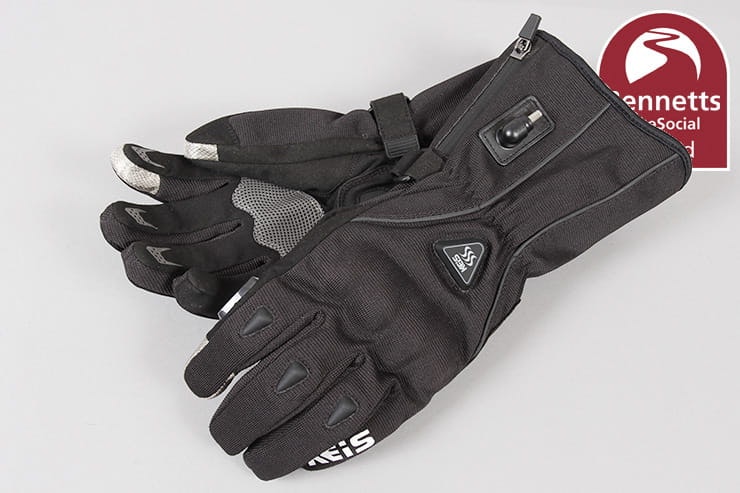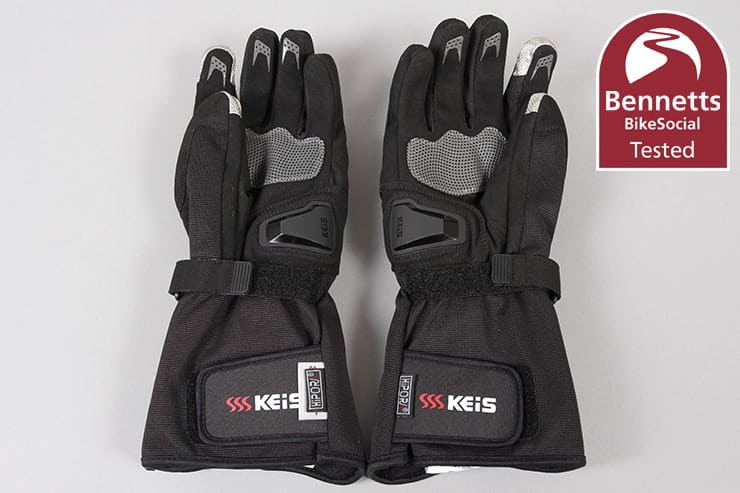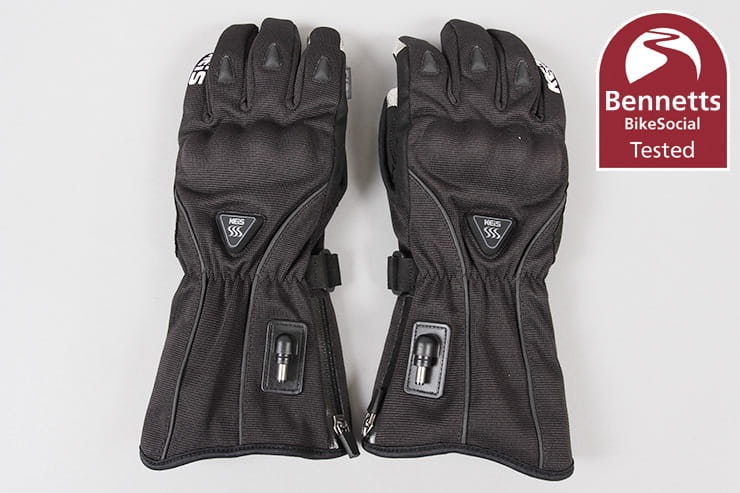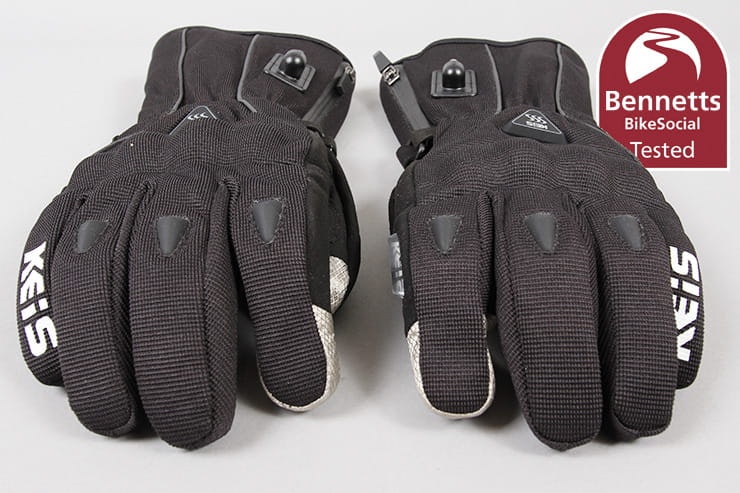Tested: Keis G701 heated motorcycle gloves review
By BikeSocial Member
Everyday riders, just like you...
08.12.2020
Date reviewed: December 2020 | Tested by: Bennetts Rewards member | Price: £199 | keisapparel.com
This review of the Keis G701 heated motorcycle gloves has been carried out by Bennetts Rewards member Patricia Stiemke…
It’s that time again: the lining has been put back in the textiles, the heated grips installed and the thick socks live at the top of the socks jumble.
When the full power of the heated grips is not enough to keep the top of your hands and fingers from freezing over in the winter breeze, the next logical step is a pair of heated gloves. During the previous cold season I have been using Blazewear inner heated gloves and they did their job very well, but the major niggle with them was the sheer bulkiness and the immobility of the fingers; winter riding gloves are quite thick to begin with, so add another layer and the controls are all that much harder to manipulate, especially if you have short fingers.
I been using the Keis G701 Bonded-Textile Heated Gloves on my CBR500R for my 90 mile commutes covering all manner of roads and at various times of the day and night…
Good craftsmanship
Superb heating technology with no hot or cold spots
Proper winter gloves
I’d have liked more heat
Long and bulky cuffs
Male connectors everywhere
Construction
The Keis G701 gloves sport an outer layer of hydrophobic ‘Ballistic Nylon’ with added Spandex to give more flexibility. This layer is heat-fused in various strips around the fingers, palms and top of the hand with a Hippora waterproof, breathable membrane, followed by a soft fluffy inner 3M Thinsulate lining that doesn’t separate when pulling the hands out of the gloves. Anyone who’s had the lining pull out of gloves will appreciate how important this is, so all credit to Keis for nailing it.
The palm and bottom of the fingers is covered in a synthetic suede-like leather and there’s a sticky patch across part of the palm to keep your hand from slipping off the grips. The ends of the first three fingers have small strips of the same anti-slip material, presumably to prevent losing grip on the levers and for manipulating switches and buttons more effectively, especially in the wet.
There’s a clear rubber wedge, aka wiper blade, on the side of the left index finger at the height of the rubber finger protectors. It’s better than nothing but it doesn’t stick out very far so you end up wiping your visor more with the glove than the wiper. I’d have liked to have seen it placed further toward the fingertip too. Still, I have my Visorcat strapped onto the glove for my wet and dirty weather needs, so I don’t need to rely on the Keis wiper edge.
The overall impression is of a high quality, well-constructed glove. The patch with the male cable connector is well secured and overall the stitching and seams seem fit for purpose, though I do have to report that a bit of fraying has occurred at the fingertips. This need not mean much though – my inner heated gloves that I used previously started fraying quite early and then just stopped at some point.
The thumb and index fingertips sport touch-screen sensitive pads. I tested their functionality, pushing, punching and swiping on various phone and pad screens, much to the amusement of my better half, without much success with the left glove, but the pads on the right glove produced slightly better results.
Fit and feel
The Keis G701 heated gloves are warm from the second you slip your hands in, with a cozy, fleecy feel – these are comfortable.
There’s enough stiffness to hint at the sturdy outer protection but not unwieldy to make you feel remote from the controls. They have the average thickness of normal winter gloves so they’ll obviously not be as dextrous as summer or racing gloves but I found them to be on the same level as my Rukka winter gloves, which have served me brilliantly as cold weather gear for the past two years. However, the Keis feel even more comfortable on the skin.
The gloves are available in sizes 5 to 13 and there’s a guide on how to measure for size on the Keis website and the company offers free returns for up to 30 days for products bought in the UK from its site, so can be sure you’ll get the right one.
The cuffs on the Keis are quite long and are flared; together with the attached protruding connector plug toward the end of the cuff, I cannot comfortably tuck them into my Richa jacket sleeves, even with the sleeve zip completely undone and the Velcro closing strap on the cuffs closed tightly. This may be less of an issue with men’s jackets as my partner has plenty of room for the cuffs in his sleeves. I do suspect though that if you use the portable battery packs in the zippered cuff pockets, it will be a bit of a struggle to tuck it all in. For my part, I have resigned myself to just closing the cuffs as tightly around my sleeves as possible and hope for the best, but just be sure to check the fit with your jacket, depending on how you like to wear the gloves with them.
Temperature
This is inevitably the most important feature of heated gloves and at 2°C and below I’d have liked more heat, even with a thin pair of inner gloves. It’s important to note though that I suffer from problems keeping my hands warm, even when sitting around at home so while at 70mph+ I’m wishing for higher temperatures, my circulation isn’t making things easy here.
I’ve used the lowest temperature setting at 8°C and that gives a nice comfortable, unobtrusive warmth that feels cozy and just right on the hands no matter what speed I’m travelling at. Another 2 degrees lower and the medium (yellow) setting is appropriate. If the thermometer sinks below that, the highest setting is needed for me. At that point, it’s not so much a feeling of warm hands but a lack of chill with a cool but not uncomfortable feel that hints at the fact that it’s not summer outside, but still leaves fingers functioning well and nimbly.
It’s a realistic gauge of the outside temperature and perhaps a reminder to start looking for ice on the road. However, as mentioned, below 3°C – especially at high speeds – it gets just too cold without the help of the heated grips and even then, the tops of my fingers struggle. I do ride a faired bike but I have to say that the fairings on my CBR do not offer the same wind protection as the ones on my old and deceased ZX-6R did. Note that motorbikes with handguards will be a lot better as they deflect the wind that causes heat to be dragged away. Beyond that and it’s bar-muffs…
I do need to heap a lot of praise on the way the heat is distributed. Keis calls it carbon fibre technology and it warms up the space in the gloves instead of along heated wires. This helps retain the heat longer and spreads the warmth evenly across all parts of the hands and fingers. It works superbly as there are no hot and cold zones and contributes to that aforementioned cozy feel. With a pair of my very thin liner gloves, even when my hands are not warm in the lowest temperatures, this overall heat distribution makes it bearable.
I will continue to use these instead of switching back to my warmer inner Blazewear gloves as I prefer living with a bit of chill on my hands to the sheer bulk and remoteness from the bike controls that they force upon me.
The gloves come with a lead to power them from the bike
Power
The gloves draw 1.6A from a 12V source via the supplied cable with a fuse box and terminal ends for the bike battery. I have the securely capped connector sticking out of the front of my seat. Pro tip: pop the caps off before putting the gloves on as they are really very well secured!
I’ve fitted the supplied Y-cable under the winter lining of my jacket and the cable is definitely long enough to accommodate quite large garments. One cable side is longer than the other, so the shorter side is for the sleeve that’s on the same side as the power connector on the bike. I don’t need to pull the battery cable connector out any further from where it sticks out of the seat to plug in the Y cable.
If you are lucky enough to have the Keis heated bodywarmer/vest then there’s a choice of separate cables for each arm that plug into armpit sockets in the vest down to the gloves. This involves less fuss regarding cables running everywhere but it makes you reliant on wearing the vest and having the cables running on the inside of the jacket’s thermal lining, rather than tucked away between the jacket’s thermal liner and the outer shell. There have been plenty of days where the bodywarmer is not needed but the gloves definitely are, so I’ve used the Y cable most. It’s good to have the choice though.
The connectors on the gloves are both male, which is a departure from the female sockets that used to be fitted to Keis gloves. They come with the cables you need, but Keis also provides free connection adaptors to anyone with pre-2020 kit as the company switches over to the new style with its new and future ranges. You can pick up the adaptors here.
These new gloves are voltage regulated, and there are no notable fluctuations in output as far as I have noticed. If you also have a Keis heated vest, bodywarmer or jacket, you can connect the gloves to the sockets under the armpits, so you’ll only need one supply lead from the bike. The same goes for heated trousers and/or insoles as the controller for the vest only affects the output of that garment.
There is the option of high-quality portable re-chargeable battery packs that can be housed in the pockets of the cuffs, but they’ll set you back £99 for the pair. If you’re planning on wearing the gloves off the bike a lot or can’t be bothered with the cable jumble in your clothes and under your bike seat, then it might well be worth the cost.
Pockets on the gloves allow the use of Keis’ 2,600mAh battery packs
Control
The control buttons for the gloves are set in sturdy rubber housings on the backs of the hands, with three temperature settings colour coded red, yellow and green. A two-second push on the housing will turn the gloves on, starting at the highest temperature setting (red) and subsequent quick pushing on the housing will cycle through the different settings with green giving the least amount of heat. Another two-second push will turn the gloves off. There’s a red check flash when you first connect the gloves to a power source.
The control buttons are easy enough to operate, though Keis naturally advises to always pull over when changing the settings on the gloves. Still, like most heated gloves, you can manipulate them while on the move if you don’t mind slowing down when fiddling with the left mitt, or you might even be able to push it with the underside of the mirror. Just be careful!
Protection and certification
The Keis G701s are approved to the latest EN13594:2015 certification with Level 1 knuckle protection. The scaphoid bone has additional protection with a hard rubber slider, and there are small strips of hard rubber over the lower finger joints, though they’re not very big.
It does seem clear that Keis has designed these heated gloves from the ground up, and there’s no doubt in my mind that this is PPE done right.
From April 21 2018, all new motorcycle clothing is deemed to be Personal Protective Equipment (PPE). To meet this legislation, it must be tested to a recognised standard. For more information on the new laws, click here.
Fastening
Fasteners are present in the form of a slim Velcro tightening strap at the wrist and a thick Velcro-lined short closing flap at the end of the cuff. There are waterproof zippered pockets in the cuffs to accommodate portable battery packs but these could be useful for small items as well.
Fitting the theme of the overall good quality of the gloves, the zippers are taped, sport a sturdy metal toggle and the Velcro pads and strips are very grippy indeed.
Wet weather use
As the gloves are fitted with a hydrophobic outer shell and a waterproof inner membrane, I would expect them to perform as well as my Rukka winter gloves in keeping my hands absolutely dry and I have to say, they do.
Being forced to wear the cuffs on the outside of the sleeves, water has leaked in but even with damp having spread inside, I didn’t feel any colder; the heating still does its job well.
I do wear some waterpoof coveralls in really bad weather, and of course the cuffs of these can be put over the gloves, totally sealing them. I’m sometimes just too lazy to don the extra layer.
During light rain you don’t even notice the moisture on the gloves, while during heavy rain, you are aware that the outside is getting very wet but the difference in wind chill is absolutely minimal. I never felt the need to switch to a higher heat setting when the gloves were soaked. As they’re not leather, you won’t damage them by carefully hanging them near a warm radiator to speed their drying.
Lining
The lining is soft and plush, made of my favourite material – 3M Thinsulate – which, as the name implies, gives an extra layer of thermal insulation and feels lovely. Even with wet-ish fingers the lining stays firmly in place when slipping hands out of gloves.
There are certainly no complaints to be had here.
Keis G701 heated gloves review: Verdict
I really like these gloves. They’re comfortable but sturdy and a good example of great winter-wear, even without the in-built heating. They’re waterproof and they’re warm.
The long, flared cuffs are obviously a drawback in terms of not fitting under my own jacket sleeves but I can live with that as I struggle to get pretty much any long-cuffed glove into them – this will of course vary with other kit.
The way the gloves distribute the heat is flawless; a steady radiance of warmth spread evenly without any hot-spots and never becoming uncomfortably hot even on the highest setting.
Keeping in mind my circulation problems, there just isn’t enough heat for those really cold days to keep the chill out of my old bones without fully employing my heated grips and wearing thin liner gloves to boot. Maybe I’m just one of those people that will always have a problem with perpetually cold hands.
If you’re not someone who has a real problem with cold extremities then these really are very good gloves. They’re not the cheapest but this is quality kit and I would hazard the opinion here that these will not fall apart any time soon. Plus Keis backs up its heating elements with a lifetime warranty.
Apparently, it’s going to be a cold winter this year. With the Keis gloves and especially the rest of the Keis heated clothing that I’m reviewing, I feel I am well prepared.



